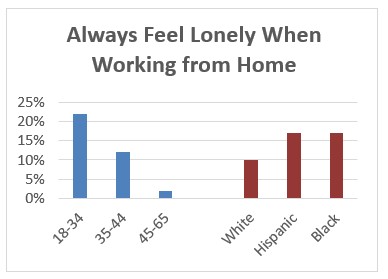Employees Say Workplaces Are Offering Fewer Mental Health Services in 2022, According to APA Poll
New Orleans, La., May 22, 2022 — As the pandemic wanes, employees report employers are offering fewer mental health services and are more reluctant to address mental health concerns in the workplace, according to the 2022 Healthy Minds poll from the American Psychiatric Association (APA). About half of employees work at home at least some of the time and about one in five works at home all the time.
Sixty percent of working adults say they know how to access mental health services through work if needed, less than the 71% in 2021 and 70% in 2020 who previously said the same. About half (48%) say they can discuss mental health openly and honestly with their supervisor, compared to 56% in 2021 and 62% in 2020. Half (52%) also say they feel comfortable using mental health services with their current employer, compared to 64% in 2021 and 67% in 2020. In addition, fewer workers feel their employer is offering sufficient mental health resources and benefits. This year 53% of workers thought the resources and benefits were sufficient compared to 65% in 2021 and 68% in 2020.
The poll, conducted by Morning Consult between April 23 and 24, 2022, was among a sample of 2,210 adults. The interviews were conducted online, and the data were weighted to approximate a target sample of adults based on gender, age, race, educational attainment, and region. Results from the full study have a margin of error of +/-2 percentage points.
In a more positive trend, fewer adults are worried about retaliation if they take time off or seek care for their mental health: 36% currently worry about retaliation if they take time off, compared to 48% in 2021 and 52% in 2020, where 31% now worry about retaliation for seeking care, compared to 43% who said this in both 2021 and 2020.
The percentage of employees reporting their employer offers several mental health-related services, such as an employee assistance program or telehealth services for mental health, has dropped over the past two years. Among working adults:
- 26% report having an employee assistance program compared to 28% in 2021 and 39% in 2020.
- 23% report their employer offering primary care coverage with sufficient mental health coverage down from 28% in 2021 and 34% in 2020.
- Nearly one in five (19%) say their employer offers telehealth services for mental health care, compared to 22% in 2021 and 27% in 2020.
- 14% have mental health days available in 2022 and 2021, down from 18% in 2020.
Over the same two years, the percentages of employees saying their employer offers none of the resources and the percentage that don’t know have increased.
- Employer offers none of the resources/benefits: 22% up from 17% in 2020.
- Don’t know about mental health resources/benefits: 21%, up from 9% in 2020.
“What’s troubling about the results of this poll is that even as the pandemic has continued and its mental health effects wear on, fewer employees are reporting that they have access to mental health services,” said APA President Vivian Pender, M.D. “Workplaces need to ensure that they are paying attention to what their employees need, particularly now, and moving away from mental health benefits isn’t the right move.”
“Also, it’s quite concerning to see that fewer people feel comfortable discussing mental health with a supervisor, at a time when people experiencing symptoms of anxiety, depression, and other conditions are on the rise and impact nearly every aspect of work, including productivity, performance, retention, and overall healthcare costs,” said Darcy Gruttadaro, J.D., Director of the APA Foundation’s Center for Workplace Mental Health. “As rates of these conditions rise, we should see more employees knowing about available workplace mental health resources, not less.”
Working from Home
Almost half of employees (46%) say they work at home at least a few days a month, down from 60% in 2021. About one in five (22%) work from home all the time, down from 32% in 2021. While there was a slight decrease in the percentage of adults experiencing negative aspects of working at home over the past year, there are still clear differences by age and race/ethnicity. Nearly half (46%) of adults who work at home say they feel lonely or isolated as a result of working from home; down from nearly two-thirds (65%) in 2021.

Among those working from home at least a few days a month, younger adults are much more likely to say they feel lonely all the time: 22% of adults 18-34 compared to 2% of adults 45-65. More Black and Hispanic adults (17% each) than white adults (10%) say they are always lonely working from home. About half (54%) of adults working from home some of the time have trouble getting away from work at the end of the day, down from 67% in 2021.
More on the Poll and Workplace Mental Health
For a copy of the full poll results, email [email protected]. Information from prior year polls is available here.
The APA Foundation’s Center for Workplace Mental Health provides tools, resources and information, to help organizations and businesses support the mental health of their workforce.
American Psychiatric Association
The American Psychiatric Association, founded in 1844, is the oldest medical association in the country. The APA is also the largest psychiatric association in the world with more than 37,000 physician members specializing in the diagnosis, treatment, prevention, and research of mental illnesses. APA’s vision is to ensure access to quality psychiatric diagnosis and treatment. For more information, please visit www.psychiatry.org.
